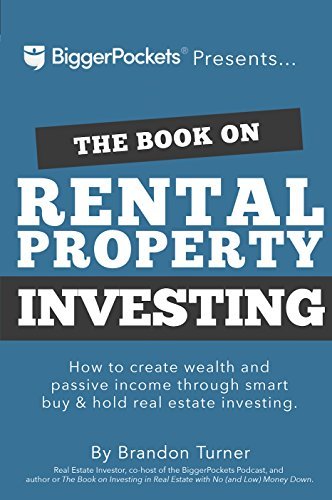How to Evaluate a Rental Property – The Basics

“Buying real estate is not only the best way, the quickest way, the safest way, but the only way to become wealthy.” -Marshall Field
Real estate is one of, if not the best asset class you can invest in. It has turned many average joes into millionaires, and is still doing it today. But you’re probably not here for me to convinced you to invest in real estate, you’re here to learn how.
Before we dive into the steps, there are a few terms and formulas you’ve gotta know, so just stick these in your mind, write them down, just do what you need to do to save them for later:
- Determining Cash Flow
- Cash-On-Cash Return
- The 50% Rule
- The 2% Test
Determining Cash Flow
When you purchase a rental property, you are typically focused on two things during the evaluation:
- Appreciation
- Cash Flow
Appreciation is an indicator of how much the value of the property increases over time. It is hard to predict appreciation, so we use a more reliable source to determine if a property is a good investment: Cash Flow.
Cash flow is simply profit – expenses. Profit is what the tenant(s) pay, expenses are everything from the mortgage, to taxes, to insurance, to rehab, to utilities, and repairs.
Cash-on-Cash Return (CoCROI)
The Cash-on-Cash Return is the ratio between how much cash flow you receive over one-year compared to how much money was invested.
CoCROI = Total Annual Cash Flow / Total Investment
Example: $2,000 / $25,000 = 8%
This means that if you collect $2,000 annually in cash flow, and you paid $25,000 for the property, your return on investment will be 8% annually.
The 50% Rule
The 50% rule is a way to get a rough estimate of what a property is worth without taking much time. That way, you can quickly see if the property is worth analyzing in-depth or not.
The 50% Rule states that “a rental property’s expenses tend to be about 50% of the income, not including the mortgage principal and interest (P&I) payment.” -Brandon Turner, The Book on Rental Property Investing
The formula for the 50% rule looks like this:
Cash Flow = (Income x .5) – Mortgage P&I
Or in simpler terms, divide your income in half and subtract the mortgage payment!
This rule is not set in stone, and also depends on your market. This is only a rough estimate that you may have to adjust for your own needs, but it is a good start to save you some time.
The 2% Test
The 2% Test is simply another metric to quickly evaluate a property and see if it may be a worthwhile investment or not. However, instead of estimating ROI or annual leftovers, we will be looking at monthly cash flow.
The 2% Test is the ratio between rental income and purchase price. A great property can be a bad deal if it is bought at too high of a price.
In order to meet the 2% test, a property’s monthly income must equal at least 2% of the purchase price. So if a property costed $100,000, then it must get at least $2,000 monthly in order to pass the 2% test.
The 2% test depends on the market, and it depends on the deal. It is only meant to be a rough estimate, so don’t take it by the book.
How to Evaluate a Rental Property
Once you’ve done some basic calculations like was shown above, you can narrow down your list of properties tremendously. Now, you can move on into a more specific evalution:
1. Figure Out Total Project Cost
If you want to know how to evaluate a rental property, the first thing you need to do is figure out how much the project will cost. This isn’t the purchase price, this is everything:
- Purchase
- Closing Costs
- Pre-Rent Holding Costs
- Estimated Repairs
Purchase
This isn’t the value of the home, this is how much you paid for it. If you buy a house worth $100,000 for $80,000, then the cost is $80,000.
Closing Costs
The closing costs are anything you have to pay associated with the transaction. This can include loan fees, insurance, property taxes, fees, attorney charges, etc.
A $100,000 property typically averages around $1,500 for closing costs, but it varies.
Pre-Rent Holding Costs
If you are purchasing a property that does not currently have a tenant, you need to have reserves set to pay the mortgage for at least a couple months, especially if you are renovating it.
Think about when you can most likely have it rented by, and set aside cash to be able to pay the mortgage payments until then, and maybe a little extra to be safe.
Estimated Repairs
There are many resources you can use to learn about estimating repairs, including the book that this article was based on. But nothing compares to the experience of looking at properties and seeing how things work.
If you want to see a brief article about the categories of home rehabs click here.
Let’s throw some numbers together in an example of the first step:
Purchase Price: $80,000
Closing Costs: $1,500
Pre-Rent Holding: $1,800
Estimated Repairs: $7,000
Project Cost: $90,300
2. Figure Out the Financing and Cost Out-of-Pocket
If you plan to pay 100% cash, you can skip this step. If you plan on using a loan to acquire the rental property, this is an important step. This step shows how much cash you need to get the deal.
The formula for figuring out out-of-pocket costs is simply
Total Project Cost – Loan Amount = Cash Needed
Most banks require a 20% down payment for conventional financing. Don’t worry, if you can’t afford 20% there are many other ways to finance a property. But for this example, we will use the typical 20%.
So the property is $80,000, the price x .2 = $16,000. This means that we will pay $16,000 to acquire the property, and the other $64,000 will be provided by the bank.
So we use the formula, and we get $90,300 – $64,000 = $26,300. So really, you need $26,300 to acquire this $80,000 property. If you don’t have it, don’t worry, there are other financing options available. This is just conventional financing.
3. Calculate the Monthly Mortgage Payment
The monthly mortgage payment will be the largest expense you have. This is the principal + interest (P&I).
To calculate the monthly mortgage payment, you need to know three things:
- Loan Amount
- Length of Loan
- Interest Rate
Of these three, the interest rate takes the most effort to find. You need to either call your local bank or estimate. Once you have an estimate, you need to use an online mortgage calculator. There are hundreds of them, and they are free to use as many times as you want. Here is an example:

You can see that with an interest of 5%, the monthly payment will be $344, and the total mortgage over 30 years will be $123,684. Don’t let that number scare you away, because you won’t be paying for it— your tenant will.
4. Determine Total Income
The official accounting term for this would be “gross profit”. This is how much rent you will receive before expenses.
To estimate this, look at homes like the ones you are looking at that are in the area, and find a range of rent prices. Find which ones are better properties, and which ones aren’t as good, and choose a safe, conservative number that you know you can get. In this case we’ll use $1,200, since others are averaging $1,300.
Total Monthly Income: $1,300
5. Determine Total Expenses
This will probably take a bit more time than determining the total income, because there is a lot more to factor in. You need to see, will you be expected to pay the utilities? The water? The electric? The lawn care? You can generally expect the following to be the expenses, and we will use a realistic example for this particular property:
- Mortgage – $344
- Property Taxes – $100
- Insurance – $160
- Capital Expenditures (10%) – $120
- Property Management (9%) – $108
- Vacancy (5%) – $60
- Maintenance (5%) – $60
Total Monthly Expenses: $952
Rent – Expenses = Monthly Cash Flow
$1,200 – $952 = $248 Monthly, x 12 = $2,976 annually.
6. Evaluate the Deal
The first metric to understand when evaluating the deal is CoCROI. (Cash on Cash Return on Investment). This metric determines how much you will make on your money annually. Much like how most people in the stock market aim for a 7-8% ROI, CoCROI is referring to cash flow.
To determine CoCROI, just do Annual Cash Flow / Cash Spent. In this case, it would be $2,976 / $26,300 = 11.3% CoCROI
ROI > CoCROI
In-case you didn’t know, CoCROI is only one way that you make your money in real estate. Just with CoCROI, you are beating the stock market annually on this average deal. But ROI (Return on Investment) is far better.
The CoCROI measures the return on investment with cash flow, but that is only one part of the overall ROI. ROI measures how much you make annually from:
- Cash Flow
- Appreciation
- Equity (Loan Paydown)
The average appreciation for a single-family home in America is 3% a year. Even though this property will more than likely appreciate faster due to the rehab, we will stick with 3% to stay safe.
3% on $80,000 is $2,400. We are using $80,000 instead of $100,000 because we are assuming that the appreciation hasn’t been priced in yet just to stay safe.
- Appreciation = $2,400
- Cash Flow = $2,976
Then you have equity coming from loan paydown. The monthly payment that you tenant covers every month, that is actually money being paid to you in equity. The bank gets their share from interest, and the rest is paying off the mortgage, which gives your property more value. The less debt there is to pay, the more equity there is for your net worth.
When calculating equity from loan paydown, you have to realize that some of the payment goes towards interest, and some goes towards principal. The problem is that typically, the loan starts out with a much higher percentage of interest than principal, and then as time goes on you start paying a higher percentage of the principal.
The more principal, the more equity you have.
After one year of loan paydown (which your tenant pays) you have about $1,000 in equity, (this depends entirely on your personal amortization schedule) which brings us to:
One Year Results
- Appreciation: $2,400
- Cash Flow: $2,976
- Equity: $1,000
Total Net Income Collected: $6,376
Assuming that there was no repair that would have costed more than your 10% Capital Expenditure savings, you will come out with $6,376. To find the total return on investment, simply divide the total net income by the purchase price:
$6,376 / $26,300 = 24.2% ROI
A 24% return on your investment in one year? And it’s going to grow even more as the years go by and your amortization schedule favors you more.
This is the beauty of rental property investing.
How to Evaluate a Rental Property
These 6 steps are the basic formula for evaluating a rental property. Obviously, there is a lot more that goes into it, but these steps play a big role in it.
This was a flat percentage scenario, obviously expect for things to work differently in your deals, but keep the same or similar guidelines relative to your market.
Credits
Most of the information in this article came from Brandon Turner’s book, The Book on Rental Property Investing.

Turner’s book is widely considered the greatest overall book on real estate investing, giving an informative guideline for almost every subject there is in rental property investing, and it was in this book that the information was provided for this article, “How to Evaluate a Rental Property”.

Brandon Turner has been investing for 13 years, and has amassed a portfolio of 300 rental units, and shares his story and information with people who want to become financially independent through rental properties. Turner is the VP of Growth for BiggerPockets, and runs the BiggerPockets real estate podcast.


